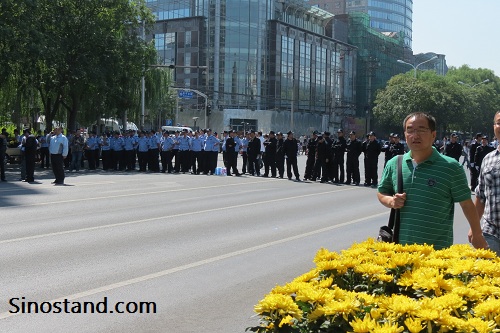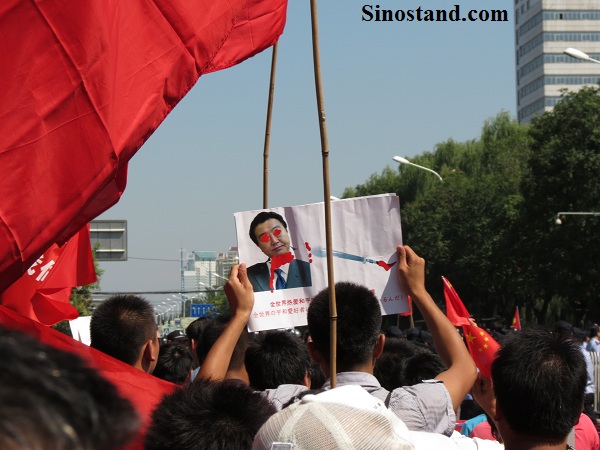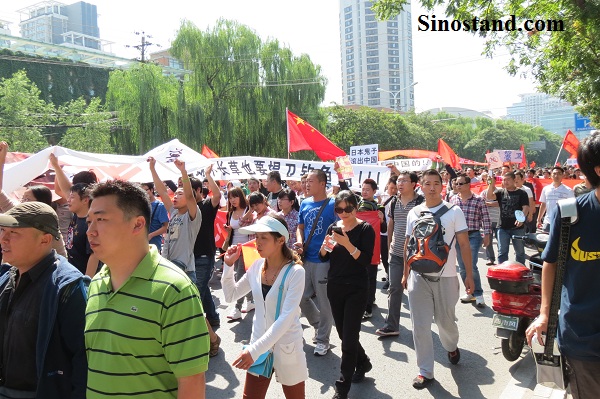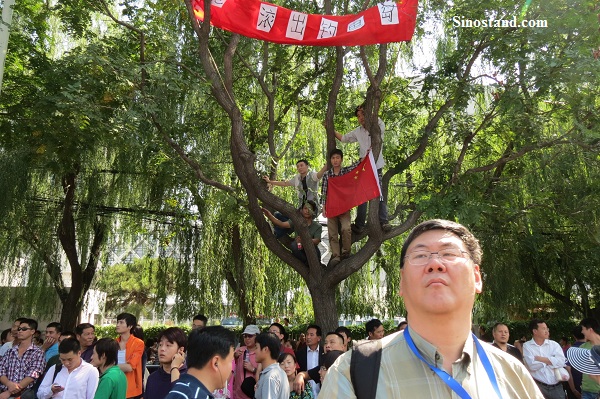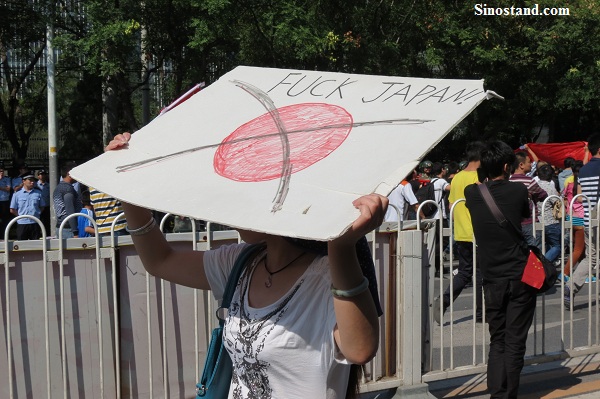I’ve hastily thrown together the below video from the protests at the Japanese Embassy in Beijing today. Pictures and account are in my last post. In the video you see when it got a bit violent after some people started throwing rocks, and when I briefly talked with one of the rock throwers. Also has a bit where the crowd unexpectedly starts chanting “Fuck the USA.” Several of the other signs and chants are subtitled.
Posts Tagged ‘Beijing’
Video From Japanese Embassy Protests
Posted: September 15, 2012 in PoliticsTags: Beijing, Diaoyu Islands, Japanese embassy, protests
On Beijing’s Anti-Japan Protests
Posted: September 15, 2012 in PoliticsTags: Anti-japan protests, Beijing, Diaoyu Islands, Japan, japanese embasy, Senkaku Islands
Today saw huge demonstrations in front of Japan’s Embassy in Beijing to protest Japanese claims over the Diaoyu Islands. Two years ago when tensions last flared over this issue, I checked out the Japanese embassy in Beijing, where there were no more than about 50 people. This time, turnout was exponentially bigger and more serious.
I got to the embassy at about 1:00 this afternoon. The roads around it were all closed off to traffic with a few hundred riot police, regular police, public security volunteers and lord knows how many plain clothes officers. I estimate there were at least 2,000 people while I was there, although it’s unclear how many actively came to protest and how many were just curious onlookers.
In the middle of the street there was a partition with police directing people to parade around it in long circles. People had huge Chinese flags and banners saying things like “Fuck little Japan.” What I was most surprised by were the number of Chairman Mao posters floating around. I asked a few people about this and the consensus was “Mao would never let Japan get away with this.”
As the crowds paraded around, they sang patriotic songs, chanted “Little Japan, fuck your mother,” “Chairman Mao 10,000 years,” “China 10,000 years” and most significantly “Communist Party 10,000 years.” (“10,000 years” basically means “Long live…”)
This mass outpouring obviously had official sanction. The police’s presence was to direct the protests rather than try to hamper them in any way.
Later things started to get a bit more intense. While the crowds circled around they were allowed to stop briefly in front of the Japanese embassy itself. It was guarded by hundreds of riot police with helmets and shields. At first protestors threw water bottles and eggs at the embassy, which police made no attempt to stop. But gradually rocks and (I assume Japanese) cell phones started to be thrown. Many of them hit the Chinese police, who were covering themselves with shields.
One man brought a bucket full of rocks, which police came and confiscated somewhat violently. After a man chucked a rock, an officer wrestled him away and said, “Enough, they’re Chinese.” He then let him go. I caught up with the man and asked him what had happened. He said, “I just wanted to fuck Japan.”
Finally I went to interview a man on the side of the road holding a sign. As I was speaking with him a police officer grabbed my shoulder and turned me around. “What are you doing,” he asked forcefully in English.
I said I was just talking with people and taking pictures. He pulled me toward a small police post on the side of the road and demanded my passport. He looked at the visa page, handed it back and then seemed to get distracted with something else. I slowly but steadily walked away.
It was very strange. It seemed like coverage was being encouraged. I didn’t notice any of the other foreigners who were taking video/pictures being hassled. I’m not sure why I was singled out.
That was about the time I headed home. If you didn’t understand what the people were chanting, the whole atmosphere of the protests seemed very festive. People chanted things, others laughed. Families with little kids were out, young people, old people. It kind of felt like a 4th of July parade…until things began to be thrown at the embassy.
This whole uproar is a godsend for the Communist Party. I never imagined I’d see people marching down the street with pictures of Mao Zedong chanting “Long live Mao, Long live the Communist Party.” It was a bit surreal. (Though several people were chastising the government for sitting by too idly)
It’s interesting to speculate on how much of this was deliberately egged on by the CCP. The whole thing erupted when the Japanese government bought some of the islands from a private owner. The move was intended to put the islands under national control so Japanese activists could be prevented from planting flags on the island and stirring up tensions. But it seems that was a huge miscalculation by Japan on the eve of China’s 18th Party Congress.
The Chinese media could have lauded the move as an attempt to ease tensions and work toward a peaceful solution, but it went hard in the opposite direction, portraying it as an illegitimate slap in China’s face. It’s no wonder so many are riled up.
It is important to note that when you see Mao posters being paraded, it’s probably a pretty poor representation of Chinese people. And it’s hard to say how many people present at the protest were active nationalists, how many came because they thought it’d be cool or interesting, and how many just happened to walk by and stuck around.
But there was a lot of intensity. Whenever someone started a chant, most joined in. This is clearly the most serious clash between China and Japan in a long time, and it could be far from over. A few days from now will be September 18th, the anniversary of Japan’s invasion of Manchuria. Unless there’s a police clampdown, the protests are likely to continue through at least that day.
With Xi Jinping back and all this intense anger directed toward Japan, I predict China’s leadership transfer can now go off without a hitch.
[Update: Below is a video I threw together of the protests with subtitles. See the rock chucker and hear a “Fuck the USA” chant]
Pictures
[If you want to use any of these pictures for anything, please either leave the watermark on or contact me to send you the original]
Another rant on Beijing’s traffic and pollution
Posted: December 26, 2011 in EconomicsTags: Beijing, pollution, traffic
The other night in Beijing I had somewhere to be at 7:00 that should take about 15 minutes to get to by bus on empty roads. But given that it’s  Beijing, I left at 5:30…and I was still 20 minutes late. In related story, the next day I opened my pollution mask to change the filter. The one on the right in that picture is a new one. The one on the left is what it looks like after a month of casual (maybe an hour per week) use in Beijing.
Beijing, I left at 5:30…and I was still 20 minutes late. In related story, the next day I opened my pollution mask to change the filter. The one on the right in that picture is a new one. The one on the left is what it looks like after a month of casual (maybe an hour per week) use in Beijing.
Some problems in China are so complex and ingrained into habit that solving them will take decades; if they can even be solved at all. This is not one of those problems.
There was recently a hilarious report that claimed Beijing commutes have been slashed from an average of 145 minutes to 60 minutes since this time last year. This incredible 170% drop supposedly happened thanks to the odd-even license plate system that’s been in effect for three years – and it happened while over 240,000 new cars hit the road. I can’t imagine a single Beijinger (who hasn’t been bed-ridden for the past year) who believes this.
The 240,000 new cars are actually down from over 900,000 new ones last year, thanks to a new annual quota on licenses. But after doing extensive calculations of all the traffic reduction measures [looking at them], I found a common fatal flaw: they still allow the number of cars to go up.
If they actually wanted to solve the problem once and for all, it would be as simple as charging a toll to drive in the city. Singapore has a brilliantly simple system where drivers have a pre-paid card on their dashboard that overhead cameras scan, deducting money automatically as they drive around town. Prices are higher during weekdays and during rush hour. If traffic starts getting a little too congested, the price goes up and, magically, less people are on the roads.
The Singapore minister of national development said, “It’s not rocket science to know that if you charge people to use certain commodities, that use is managed and controlled.”
No, it’s not rocket science. It’s freshman economics 101. Use incentives and disincentives properly to achieve the desired result. Yet this is a concept that continues to elude many governments around the world.
While the number of cars has surged parking prices have naturally followed. The average cost of buying a parking space in the Beijing is now around 140,000 yuan ($21,726) while some spaces are fetching upwards of 800,000 yuan ($124,316). So what is the government doing? Accommodating the upset drivers by building 200,000 new spaces. If they had attended said economics 101, they would realize that when this measure makes parking more abundant, more people will have incentive to buy cars. Ditto if more roads are built. The problem will be solved very briefly, and then become worse. This is why several major cities have put caps on the number of new spaces that can be built.
The current measures being taken to alleviate traffic are all essentially gimmicks to pacify the greater public while avoiding too much agitation of car manufacturers and drivers. China doesn’t want to miss out on the boon that an auto industry gives the economy and the government doesn’t want to upset drivers – who are quickly becoming as whiny as Americans in defending their “need” and “right” to having a car.
Then there’s the social stability concern. Several drivers have beaten, and even killed, parking attendants over high fees. But, to put that in perspective, the average life-expectancy of a Chinese traffic cop is 43. And how many others are having their lives shortened with blackening lungs each day and dying in traffic on the way to the hospital?
A Singapore-type measure wouldn’t solve Beijing’s horrific pollution completely, but it would help immensely. And it would, without a doubt, solve the traffic problem. In fact, it would work in any city that has a decent public transportation infrastructure. It would dent China’s auto industry, but if the government thinks it can develop the car culture the same way America did, we may as well all start digging our graves now.
Drivers would be upset, but frankly they can cry me a river. Why shouldn’t they pay for their negative externalities? It would be an egalitarian measure all around that does good for the maximum amount of people. Is there something I’m missing here?


